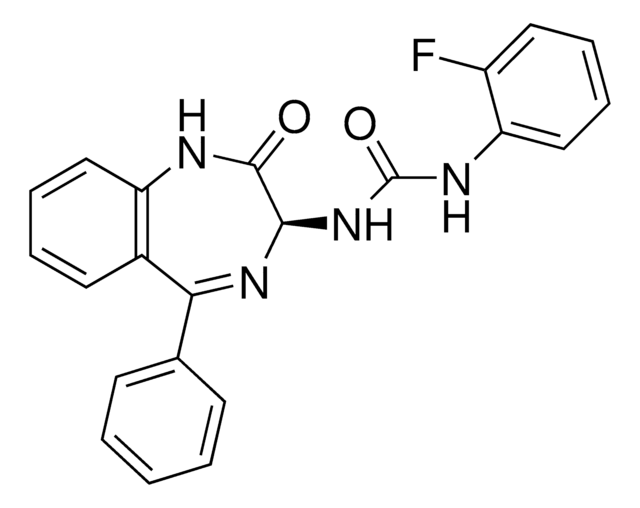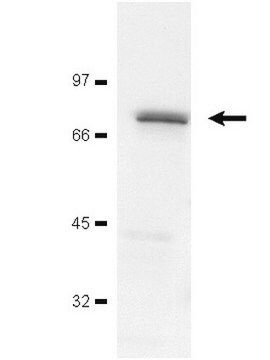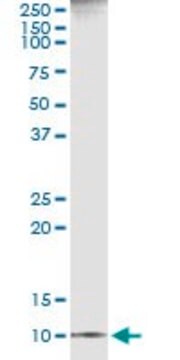SRP3214
I-TAC (CXCL11) from mouse
recombinant, expressed in E. coli, ≥98% (SDS-PAGE), ≥98% (HPLC), suitable for cell culture
Synonym(s):
B-R1, CXCL11
Sign Into View Organizational & Contract Pricing
All Photos(1)
About This Item
UNSPSC Code:
12352202
NACRES:
NA.32
Recommended Products
biological source
mouse
recombinant
expressed in E. coli
assay
≥98% (HPLC)
≥98% (SDS-PAGE)
form
lyophilized
potency
10.0-100.0 ng/mL
mol wt
9.0 kDa
packaging
pkg of 20 μg
technique(s)
cell culture | mammalian: suitable
impurities
<0.1 EU/μg endotoxin, tested
color
white to off-white
UniProt accession no.
shipped in
wet ice
storage temp.
−20°C
Gene Information
mouse ... CXCL11(56066)
General description
CXCL11 (C-X-C motif chemokine 11), also referred to as I-TAC (interferon-inducible T-cell α chemoattractant), is from to the CXC chemokine family and is an antagonist for CC chemokine receptor 3 (CCR3) and CCR5. CXCL11 was first identified in astrocytes via cDNA sequencing. It can be induced by IFN (interferon)-γ in different cells. CXCL11 interacts with and signals via CXCR3 (C-X-C chemokine receptor type 3).
Recombinant murine I-TAC is a 9.0kDa protein containing 79 amino acid residues including the four highly conserved cysteine residues present in CXC chemokines.
Recombinant murine I-TAC is a 9.0kDa protein containing 79 amino acid residues including the four highly conserved cysteine residues present in CXC chemokines.
Biochem/physiol Actions
CXCL11 (C-X-C motif chemokine 11) is involved in the wound repair in skin cells. CXCL11′s interaction with CXCR3 (C-X-C chemokine receptor type 3) polarizes naive T cells into IL (interleukin)-10hi Tregs (regulatory T cells, Tr1) and repolarizes CXCR3+CD4+ EAE (experimental autoimmune encephalomyelitis)-associated effector T cells into IL-10hi Tregs. CXCL11 also enhances Th2 (T helper 2) response in model leishmaniasis system, and thereby regulates the outcome of the immunological pathway. In mice model, CXCL11 is upregulated in RSV (respiratory syncytial virus) and influenza A infections.
Sequence
FLMFKQGRCL CIGPGMKAVK MAEIEKASVI YPSNGCDKVE VIVTMKAHKR QRCLDPRSKQ ARLIMQAIEK KNFLRRQNM
Physical form
Lyophilized with no additives.
Reconstitution
Centrifuge the vial prior to opening. Reconstitute in water to a concentration of 0.1-1.0 mg/ml. Do not vortex. This solution can be stored at 2-8°C for up to 1 week. For extended storage, it is recommended to further dilute in a buffer containing a carrier protein (example 0.1% BSA) and store in working aliquots at -20°C to -80°C.
Storage Class
11 - Combustible Solids
wgk_germany
WGK 3
flash_point_f
Not applicable
flash_point_c
Not applicable
Certificates of Analysis (COA)
Search for Certificates of Analysis (COA) by entering the products Lot/Batch Number. Lot and Batch Numbers can be found on a product’s label following the words ‘Lot’ or ‘Batch’.
Already Own This Product?
Find documentation for the products that you have recently purchased in the Document Library.
CXCL11-dependent induction of FOXP3-negative regulatory T cells suppresses autoimmune encephalomyelitis.
Zohar Y, et al.
The Journal of Clinical Investigation, 124, 2009-2009 (2014)
Characterization of the chemokine CXCL11-heparin interaction suggests two different affinities for glycosaminoglycans.
Severin IC, et al.
The Journal of Biological Chemistry, 285, 17713-17713 (2010)
Regulation of C-X-C chemokine gene expression by keratin 17 and hnRNP K in skin tumor keratinocytes.
Chung BM
The Journal of Cell Biology, 208, 613-613 (2015)
A recombinant vaccinia virus encoding the interferon-inducible T-cell alpha chemoattractant is attenuated in vivo.
Hamilton NH, et al.
Scandinavian Journal of Immunology, 59, 246-246 (2004)
Epidermal expression of I-TAC (Cxcl11) instructs adaptive Th2-type immunity.
Roebrock K, et al.
Faseb Journal, 28, 1724-1724 (2014)
Our team of scientists has experience in all areas of research including Life Science, Material Science, Chemical Synthesis, Chromatography, Analytical and many others.
Contact Technical Service








